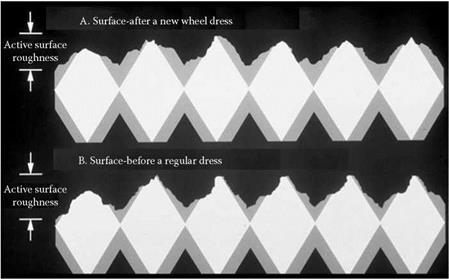The other effect of very fine dress infeed depths is related to the fact that the dress depth becomes comparable to or significantly less than the depth to which the surface of the wheel has been affected by previous grinding. The surface of any grinding wheel is significantly modified compared to its bulk structure. The dressing process fractures and removes abrasive particles and bond to reduce the surface concentration of both.
Yokogawa and Yonekura [1983] were the first to describe this affected layer, which they termed “Tsukidashiryo,” also known as “Active Surface Roughness”; this can vary in depth from a few microns to over 30. For most medium — to high-stock removal applications, once grinding begins the abrasive metal chips will wear the bond preferentially and further increase the affected depth (Figure 7.22). This effect is accompanied by a drop in grinding forces and a rise in surface roughness and is most striking for the first few parts after dress. Figure 7.23 illustrates the expected trend for
|
FIGURE 7.22 Concept of “active surface roughness.” |
various crush ratio parameters based on Jakobuss and Webster [1996]. In many cases, the CBN abrasive is virtually unaffected by the grinding process and changes in grinding parameters and wear is entirely the result of bond wear leading to the grits finally falling out [Williams and Yazdzik 1993]. For this reason, wheel wear often becomes very unstable after 10 to 20 pm depending on grit size.

